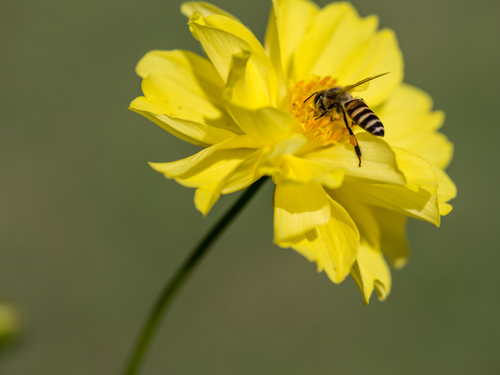 Bees play an important role in our ecosystem by pollinating flowers, so it’s a good idea to keep your distance and let them do their thing when you spot one outside. However, they can be dangerous when they get too close to comfort – especially if you or a family member is allergic to their stings. Here’s what you need to know if you have bees nesting in (or around) your home.
Bees play an important role in our ecosystem by pollinating flowers, so it’s a good idea to keep your distance and let them do their thing when you spot one outside. However, they can be dangerous when they get too close to comfort – especially if you or a family member is allergic to their stings. Here’s what you need to know if you have bees nesting in (or around) your home.
Know the Different Types of Bees
Each type of bee looks and acts differently, and may require a different approach to remove. Among the most common bees are bumblebees and carpenter bees. These two species look very much alike, except that bumblebees have a hairy abdomen, while carpenter bees have a shiny, black abdomen.
Bumblebees nest in the ground and are social insects, while carpenter bees tunnel into wood and are solitary. Bumblebees are typically not aggressive, but will defend their nest if they feel threatened, stinging victims multiple times. That means you may be at risk of a bumblebee attack if a bumblebee nest is in a high-traffic area in your yard.
Carpenter bees also avoid attacks unless provoked, and while males are territorial, they can’t sting. But carpenter bee stings are the least of your problem with this species — they pose a risk to the structure of your home, since they burrow into it.
Another common type of bee is the honey bee. These bees are very social and live in hives. They are smaller than bumblebees and carpenter bees, and are striped yellow and brown. Honey bees will swarm and attack if they feel their hive is threatened, but can only sting their victims once before dying.
Know How to Identify an Infestation
Have you noticed a lot more bees flying around your property? This is the first sign of a bee infestation. You might also see their nests around your home, such as on the side of buildings, in trees, or in holes in the ground. You may also spot coarse sawdust near where carpenter bees have begun burrowing in.
Other signs of a bee infestation include:
- Dead bees inside the home
- A buzzing noise inside the walls
- Unpleasant odors, which come from rotting honeycomb
- Holes in wooden structures, which are also caused by carpenter bees
Know the Dos and Don’ts of Handling Bees
Handling bees on your own can be a risky business, and you definitely shouldn’t attempt it if you are allergic to bee stings. If you suspect you have a bee infestation, be sure to:
- Wear shoes outside
- Keep your trashcans covered, and empty them regularly
- Seek medical attention if you’re stung and the reaction is severe
Do not be tempted to:
- Swat at bees, as this can provoke them
- Crush them, as the smell can attract more bees
- Try to exterminate them on your own
Know When to Call Pest Control
Bees don’t have to be bad news; if they’re far enough away from structures like your house and garage, then it can be perfectly safe to let them be. Just don’t threaten their nests. But if there’s a hive in a high-traffic area of your property, or if carpenter bees are compromising the structure of your home, it’s time to call in professional help.
Contact Adios Pest Control today for help protecting your family and your home from a potentially dangerous bee infestation.

